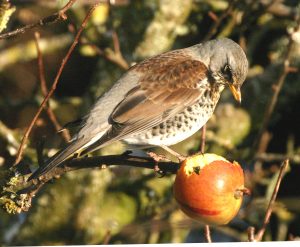 If you were considering listing the rarest breeding birds in Scotland, including the Highlands, then the birds of prey would come to mind such as golden eagle and sea eagle. The golden eagles stand at around 400 pairs whilst the re-introduced sea eagles are at around 100 pairs. Then there are a few birds that are even rarer such as the Slavonian grebe with around 25 pairs that only breed within a small area around Inverness with their base at Loch Ruthven, a few miles south of Inverness where there is a RSPB Hide. One of the ducks, the common scoter is very rare as a breeding bird at 80 pairs. Looking at the small birds, one that readily comes to mind is the snow bunting that nest on the high tops with only 50- 60 pairs.
If you were considering listing the rarest breeding birds in Scotland, including the Highlands, then the birds of prey would come to mind such as golden eagle and sea eagle. The golden eagles stand at around 400 pairs whilst the re-introduced sea eagles are at around 100 pairs. Then there are a few birds that are even rarer such as the Slavonian grebe with around 25 pairs that only breed within a small area around Inverness with their base at Loch Ruthven, a few miles south of Inverness where there is a RSPB Hide. One of the ducks, the common scoter is very rare as a breeding bird at 80 pairs. Looking at the small birds, one that readily comes to mind is the snow bunting that nest on the high tops with only 50- 60 pairs.
One group of birds that would not readily come to mind are the thrushes as after all there are an estimated 100,00 to 150,000 fieldfares wintering in Scotland and there may be around 1.5 million on passage. Occasionally fieldfares will come into the garden in winter like the one I photographed here. The same can be said of the redwings although the numbers are less at 90,000 wintering birds, mainly from Iceland but also Scandinavia. In contrast there are up to 1 million breeding pairs of blackbirds in Scotland and around 250,00 pairs of breeding song thrushes. So where do the rare breeding thrushes come from?
There are only up to five pairs of fieldfare nesting in Scotland each year and, at 40 to 80 pairs, not that many more redwings. It always intrigues me as to whether the few breeding birds of both species just ignore their relatives flying over. Or do they join in and leave it to others to stay and breed, almost on a rota basis? These thrushes migrate at night and you can imagine their call notes from the darkness above and the breeding birds on the ground and choosing to ignore them! Even when the redwings and fieldfares arrive on migration from Iceland and Scandinavia they only stay in the Highlands as long as the food supply shuck as rowans hold out. Once the berries are gone they move on but do the residence breeding birds just ignore them again?
Redwings fascinate me the most perhaps because they bred a few years back just outside the garden in a line a dense blackthorn. Their jumbling notes that go for its song seemed strange mingling with the song of the blackbirds. I wondered at the time just how many such isolated pairs go undetected in the Highlands. The nest in the blackthorn was several feet up but in Iceland, where I have seen them, more often than not the nest is on the ground. Not only that but they also nest in colonies. Presumably this is because in Iceland there are far fewer predators. The cup shaped nest is built by the female and is of grasses, twigs and moss. Only the female incubates the 4 or 5 eggs but both male and female feed the chicks. If the female decides on a second brood, that often happens, then the male will carry on feeding the young on his own. With so very few suitable berries available in the summer the birds feed on worms, snails, slugs and insects. The first known pair to nest in Scotland was in Inverness-shire in 1932 and the numbers have grown gradually since that time. The very low numbers make it difficult to assess any trends.
Tags: highland birds
